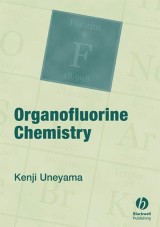Details

Organofluorine Chemistry
1. Aufl.
|
206,99 € |
|
| Verlag: | Wiley-Blackwell |
| Format: | |
| Veröffentl.: | 15.04.2008 |
| ISBN/EAN: | 9781405172936 |
| Sprache: | englisch |
| Anzahl Seiten: | 350 |
DRM-geschütztes eBook, Sie benötigen z.B. Adobe Digital Editions und eine Adobe ID zum Lesen.
Beschreibungen
The replacement of hydrogen with fluorine in organic molecules can profoundly influence their chemical and physical properties, leading to a range of compounds with highly desirable properties. These molecules are of interest across the wide spectrum of industrial and academic organic chemistry, so that organofluorine chemistry is economically highly important. <br /> <p><br /> </p> <p><i>Organofluorine Chemistry</i> will help chemists to develop a systematic knowledge of the chemistry of fluorine with a view towards its application in the design of new reactions and syntheses, and the creation of novel fluorinated molecules and materials. With initial chapters focusing on why fluorine creates such unique properties in organic compounds, the book then covers general reactions of fluorine. Coverage is chosen from the recent research literature, concentrating on the development of novel bioactive compounds and catalytic ligands, and explaining, in the context of the initial chapters, how and why fluorine is so effective. With a final chapter covering the general synthetic chemistry of organofluorine compounds, the book is a cohesive summary of the fundamental principals of organofluorine chemistry.</p>
Preface. <p><b>1. Fundamentals in organic fluorine chemistry</b>.</p> <p>1.1 Some physical properties of organic fluorine compounds.</p> <p>1.2 Electronic effect.</p> <p>1.2.1 Electronic effects of the fluorine atom – insight from Hammett substituent.</p> <p>constants.</p> <p>1.2.2 Electronic effects on acidity, bond length, and bond energy of fluoroorganic.</p> <p>molecules.</p> <p>1.2.3 Halogen bonding.</p> <p>1.2.4 Electronic effect to the destabilization of carbonyl and imono groups.</p> <p>1.2.5 p-p Stacking of fluoroaromatics.</p> <p>1.2.6 Increased p-character (Bent’s rule) and low-lying LUMO in carbon-fluorine.</p> <p>bonding orbitals.</p> <p>1.2.7 Negative hyperconjugation.</p> <p>1.2.8 Electron-donating effect (Stabilization of carbocation).</p> <p>1.2.9 Effect of fluorine substituents to the structure, stability, and reactivity of.</p> <p>fluoroalkyl radicals.</p> <p>1.3 Steric effects of fluorine substituents.</p> <p><b>2. Unique reactions induced by fluorine</b>.</p> <p>2.1 Nucleophilic substitution on fluoroaromatic rings.</p> <p>2.2 SN2’ reactions of alkenes bearing trifluoromethyl group.</p> <p>2.3 Nucleophilic substitution on gem-difluoromethylene carbon.</p> <p>2.4 Single electron transfer (SET) reaction of perfluoroalkyl halides.</p> <p>2.5 Fluorine-activated electrophilic reagents (F-X and XFn).</p> <p><b>3. Reactions activated by a strong interaction between fluorine and other atoms</b>.</p> <p>3.1 Reaction induced by F-Li interaction.</p> <p>3.2 Reaction induced by F-Al interaction.</p> <p>3.3 Reaction induced by F-Si interaction.</p> <p>3.4 Reaction induced by F-B interaction.</p> <p>3.5 Other examples (Sm, Yb, Zr, Hf).</p> <p><b>4. Hydrogen bonding in organofluorine compounds</b>.</p> <p><b>5. Fluorinated ligands for selective catalytic reactions</b>.</p> <p><b>6. Fluorine in drug designs</b>.</p> <p><b>7. Methods for introduction of fluorine-functionality into molecules.</b></p> <p><b>(Summary from publications for the latest fifteen years)</b>.</p> <p>7.1 Monofluorination.</p> <p>7.2 Difluorination.</p> <p>7.3 Trifluoromethylation.</p> <p>7.4 Perfluoroalkylation.</p> <p>Index</p>
I strongly recommend it to every practitioner of organofluorine chemistry.<br /> <p>...this book is a detailed and thorough review as well as a valuable source of information with numerous tables, detailed formula schemes, some helpful illustrations, and well referenced citations from the recent literature. Graduate students and research chemists working in the field should read this book to deepen their understanding of organofluorine chemistry and in particular to gain more insight into their enormous synthetic potential.<br /> </p> <p>Journal of the American Chemical Society VOL. 128, NO. 51, 2006<br /> </p> <p><br /> </p> <p>This book is well written and with plenty of useful references.<br /> </p> <p>Organic Process Research and Development Journal</p>
<b>Kenji Uneyama</b> is Professor of Chemistry in the Department of Applied Chemistry, Okayama University, Okayama, Japan.
The replacement of hydrogen with fluorine in organic molecules can profoundly influence their chemical and physical properties, leading to a range of compounds with highly desirable properties. These molecules are of interest across the wide spectrum of industrial and academic organic chemistry, so that organofluorine chemistry is economically highly important. <br /> <p><br /> </p> <p><i>Organofluorine Chemistry</i> will help chemists to develop a systematic knowledge of the chemistry of fluorine with a view towards its application in the design of new reactions and syntheses, and the creation of novel fluorinated molecules and materials. With initial chapters focusing on why fluorine creates such unique properties in organic compounds, the book then covers general reactions of fluorine. Coverage is chosen from the recent research literature, concentrating on the development of novel bioactive compounds and catalytic ligands, and explaining, in the context of the initial chapters, how and why fluorine is so effective. With a final chapter covering the general synthetic chemistry of organofluorine compounds, the book is a cohesive summary of the fundamental principals of organofluorine chemistry.</p>
I strongly recommend it to every practitioner of organofluorine chemistry.<br /> <p>...this book is a detailed and thorough review as well as a valuable source of information with numerous tables, detailed formula schemes, some helpful illustrations, and well referenced citations from the recent literature. Graduate students and research chemists working in the field should read this book to deepen their understanding of organofluorine chemistry and in particular to gain more insight into their enormous synthetic potential.<br /> </p> <p>Journal of the American Chemical Society VOL. 128, NO. 51, 2006<br /> </p> <p><br /> </p> <p>This book is well written and with plenty of useful references.<br /> </p> <p>Organic Process Research and Development Journal</p>

















